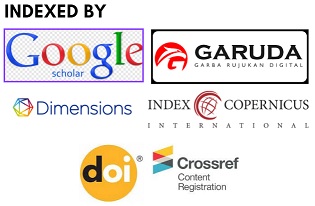HUBUNGAN FAKTOR IBU, POLA PEMBERIAN MAKANAN DAN ASI EKSKLUSIF DENGAN KEJADIAN STUNTING PADA BALITA 12-59 BULAN DI KELURAHAN BATARAGURU
DOI:
https://doi.org/10.55340/kjkm.v5i1.984Keywords:
Stunting, Faktor Ibu, PolaPemberian Makan, ASI EksklusifAbstract
National Basic Health Research in Indonesia showed stunting increased from 36.8% to 37.2%. The purpose of this study was to find out the relationship between maternal factors, exclusive feeding and breastfeeding patterns with stunting events in toddlers aged 12-59 months in the working area of the Bataraguru Village Health Center.
The type of research used is quantitative research with a case control approach. The population in this study was 621 toddlers. The subjects in the study were all selected cases and controls with a case ratio and 1:1 control. Data processing is carried out using the SPSS . The data analysis in this study is univariate and bivariate, using the Chi-Square Test statistical test by reviewing the p-value test if < alpha (a=0.05) is said to be related.
Stastistic test results found that variables unrelated to stunting events were maternal factor (p = 0.032 < 0.05), feeding patterns (p = 0.361 > 0.05), Exclusive breast milk (p = 0.309 > 0.05).
The conclusion of this study is that there is a relationship between maternal factors and the incidence of stunting in toddlers 12-59 months in Bataraguru Village. There is no relationship between the pattern of exclusive feeding and breastfeeding and the incidence of stunting in toddlers 12-59 months in Bataraguru Village. The advice from researchers is that it is hoped that mothers of toddlers can prepare themselves during pregnancy by increasing knowledge so as to reduce the risk of stunting in toddlers.
Downloads
References
Anshori, A. (2013). Faktor Risiko Kejadian Stunting Pada Anak Usia 12-24 bulan (Studi Di Kecamatan Semarang Timur). Journal Of Nutrition College, 2(4). https://ejournal3.undip.ac.id/ index.php/jnc/article/view/3830
Irawati, Fahrurazi dan Anggraeni, S. (2020). Faktor-Faktor Yang Berhubungan Dengan Kejadian Stunting Pada Balita 12-59 Bulan Di Wilayah Kerja Puskesmas Parenggean I Tahun 2020. Universitas Islam Kalimantan. Kalimantan Selatan Karundeng, L. R., Ismanto, A. Y., & Kundre, R. (2015). Hubungan jarak kelahiran dan jumlah anak dengan status gizi balita di Puskesmas Kao Kecamatan Kao Kabupaten Halmahera Utara. Jurnal Keperawatan, 3(1).
Kemenkes RI. (2015). INFODATIN. In Pusat data dan Informasi KEMENKES RI. https://doi.org/10.1007/978-4-431-55357-1_23
Kemenkes RI. (2016). INFODATIN . Scance, ISSN 2442-(Hari anak Balita 8 April), 1–10.
Mulyati H, Hertaty TP, Hasnidar dan Rahmi N. (2021). Studi Case Control: Kebiasaan Makan Dan Hubungannya Dengan Kejadian Stunting Pada Anak Balita Di Desa Padende Kecamatan Marawola. Jurnal Ilmu Kesehatan Bhakti Husada Vol. 12 No. 01. DOI: 10.34305/JIKBH.V12I1.252
Nasikhah, R dan Margawati, A. (2012). Faktor risiko kejadian stunting pada balita usia 24-36 bulan di Kecamatan Semarang Timur. Journal of Nutrition College,1(1). http:// www.ejournal-s1.undip.ac.id
Pratiwi, R. H., Suyatno, & Aruben, R. (2015). Faktor-Faktor Yang Berhubungan Dengan Berat- Kurang (UnderWeight) Pada Balita Di Perkotaan Dan Perdesaan Indonesia Brdasarkan Data Riskesdas Tahun 2013. Journal Kesehatan Masyarakat, 3(8), 1689–1699. https://doi.org/10 .1088/1751-8113/ 44/8/085201
Riskesdas. (2013). Riset Kesehatan Dasar. Science,1–304. https://doi.org/10.112 6/science.127.3309.1275
Syam, I., Yulianita, M., & Annisa, I. (2019). Factors Associated With Stunting in Toddlers in Working Area of Buntu Batu Health Center Enrekang Regency Faktor. Jurnal Kesehatan Masyarakat Mulawarman, 1(2), 8–16. https://core. ac.uk/download/pdf/276528197.pdf
TNP2K. (2017). 1000 Kabupaten/Kota Prioritas Untuk Penanganan Anank Kerdil (Stunting) (Vol. 1, Issue 1)
United Nation Children Emergency Fund. (2013). Improving Child Nutrition the Achievable Imperative For Global Progress. New York.














